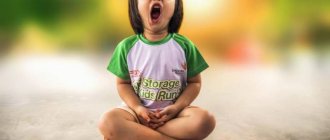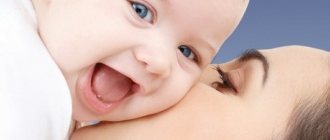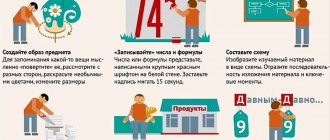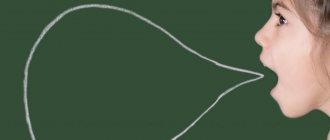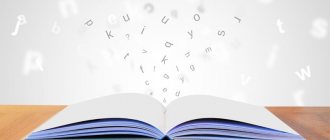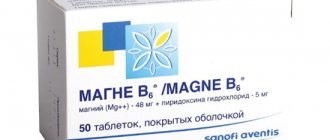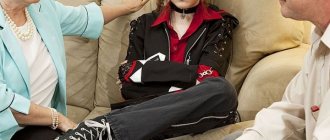What are the benefits of art therapy for children?
Art therapy for children has become widespread. It has many types, among which children can choose the direction they like. For example, isotherapy, music therapy
, puppet therapy, etc.
Children's art therapy promotes:
- development of creative skills;
- development of communication abilities;
- tolerant attitude towards others;
- revealing the inner potential of the individual;
- broadening your horizons and understanding of the world.
Using elements of art therapy for the successful adaptation of young children to preschool educational institutions
Anastasia Gladkova
Using elements of art therapy for the successful adaptation of young children to preschool educational institutions
Prepared by the teacher of the Regional Educational Institution "Umka"
Gladkova Anastasia
Using elements of Art Therapy for the successful adaptation of young children to the conditions of a preschool educational institution
The process of a child getting used to kindergarten is quite lengthy and is associated with significant stress on all physiological systems of the child’s body. The adaptive capabilities of a young child are limited , so a sudden transition of a child to a new social situation and a prolonged stay in a stressful state can lead to emotional disturbances or a slowdown in the rate of psychophysical development.
Thus, teachers of adaptation groups have an important task - to help children overcome stress when entering a preschool institution and successfully adapt to it .
In this case, a method of positive psychological influence is needed in order to maintain and strengthen the child’s mental balance. The most optimal approach to ensuring the adaptation of young children can be considered a creative approach that reveals the personality and individuality of each child.
For us, it turned out to be an effective method during the period of children’s adaptation to new conditions - the method of art therapy .
Art therapy is based on art, primarily visual and creative activities.
The phrase " art therapy "
in the scientific and pedagogical interpretation it is understood as caring for the emotional well-being and psychological health of the individual and group through artistic activity.
Using elements of art therapy allows us:
— Create a positive emotional mood;
— Relieve emotional stress;
(this is especially important for us at the initial stage of adaptation )
— Reduce fatigue, negative emotional states and their manifestations;
— Increase adaptive abilities to everyday life in kindergarten;
— Develop imagination, visual arts skills, and artistic abilities in general.
— The opportunity to address the child’s unspoken fantasies and desires.
In working with children, we strive to achieve mutual understanding between children, as well as between children and adults. Children learn to express themselves, manage their feelings, experiences, and emotions.
In addition, the use of the art therapy method also promotes the development of thinking, logic, imagination, memory, attention, speech, fine motor skills, creativity, skills for successful interaction with peers and adults, and, of course, the child’s excellent well-being.
Art therapy has proven to be a productive and indispensable method in working with children and one of the softest and most effective methods used by teachers .
Art therapy is divided into the following methods: isotherapy, fairy tale therapy, play therapy, sand therapy, music therapy, phototherapy.
We will pay special attention to two elements of art therapy (isotherapy and sand therapy)
We will bring to your attention practical recommendations on the use of isotherapy in working with young .
Isotherapy as a method of art therapy
Isotherapy is therapy, primarily drawing. All types of art materials are suitable for isotherapy. We use paints , pencils, wax crayons, paper of various textures, brushes of different sizes and hardness. Classes are not limited to the usual set of visual arts (paper, brushes, paints)
and traditional ways
of using . use unconventional methods.
There are many ways to create images:
Drawing with bulk products. To do this, we use cereals painted with food coloring or gouache (semolina, rice, millet peas, pasta)
.
When applying an image with your fingers and palms, sponges and feathers, blots turn into butterflies, spots of paint into unprecedented animals. The guys feel their success .
“staining” technique
.
In the literal sense, “to dirty”
means
“to dirty, to dirty
.
We smear, splash paints, and apply many layers and mix colors. For this we use gouache or watercolor paints.
The most saturated in embodiment and emotionally vivid are gouache or watercolor images. Technique “Drawing in a circle”
We use this technique during group work - it promotes group cohesion.
Technique “Paired drawing”
Joint drawing teaches
children cooperation
Technique “Plasticine composition”
Plasticine is applied with your fingers to the cardboard, as if it were spread.
Finger Painting Technique
This technique promotes the development of fine motor skills of the hands, concentration, and coordination of movements under visual control. Not all children want to draw with their fingers; some, having tried this method, return back to a brush or sponge, as more familiar means of depiction.
Sand therapy
All games with sand are divided into two directions:
— Educational (they facilitate the child’s adaptation )
.
— Cognitive (with their help, the diversity of our world )
.
Why is sand painting so useful?
— the child develops the interest of a researcher. After all, the activity is usually surrounded by mystery.
— playing with sand, the child relaxes.
- the child fantasizes with sand more boldly than on paper with pencils or paints. Here you can draw, correct and draw again.
— drawing with sand promotes the development of fine motor skills.
According to experts, this technique is even more effective than finger gymnastics. Because working with sand is more stressful and
brain and muscles
To play with sand, we use a special container for sand and water with a lid; There is a wooden box of special sizes (for 1-3 children it should be 50x70x8 cm.)
Such dimensions were not chosen by chance; this is the optimal field of visual perception for a child, he is able to embrace it entirely.
Clean sand (calcined in the oven, sifted (sand can be replaced with semolina)
.
We use the following exercise games with sand:
Our handprints.
The surface of the sand is smooth. The child, together with the teacher, takes turns making handprints, either with the inside or the outside. You need to lightly press your hand into the sand and listen to your feelings.
Fist prints (find similarities with a familiar object - flower, sun, hedgehog)
;
Slide your palms along the surface of the sand (zigzag and circular movements - like a car driving, like a snake crawling)
; the same, placing your palm with an edge;
"Walk"
alternately with each finger of the right and left hand
(then two at the same time)
;
"Play"
fingers on the surface of the sand, like on a piano (soft
“up and down”
- the brush moves);
Leave marks with two fingers or five fingers at the same time (fantasize together: whose marks are these?)
.
"Sand Rain"
The child slowly and then quickly pours sand from his fist...
"Sand Hide and Seek"
etc.
To play in the sandbox, we suggest that the child use various miniature toys, no more than 8 cm.
Before playing with sand, children can be introduced to the “Keeper of the Sand”
(this can be any toy, it tells the basic rules that must be followed during the game.
Watching children play in the sandbox , you can see how sand has a positive effect on emotional well-being and is an excellent tool for the development and self-realization of a child.
Conclusion
At the end of my speech I would like to say that:
Art therapy has neither restrictions nor contraindications; it is a gentle and safe method when working with a child’s psycho-emotional state, giving him the opportunity to feel freedom of his actions. The use of art therapy during the adaptation period makes its course milder.
The formation of adaptation mechanisms depends primarily on the ability of teachers to create a natural stimulating environment in which the child feels comfortable and protected, showing creative activity.
Art therapy classes in
The developer invites children from 3 to 8 years old to art therapy classes in the field of fine arts.
The main goal of correctional art therapy classes is to give children the opportunity to get rid of negative emotions through creativity, using artistic images and symbols.
The course allows you to solve the following problems:
- achieve positive changes in intellectual, emotional and personal development;
- express anger and aggression in a socially acceptable manner;
- gain new knowledge about yourself and the people around you;
- resolve internal and external conflicts;
- obtain material for interpretation and diagnostic conclusions;
- express thoughts and feelings that the child is used to suppressing;
- develop fine motor skills;
- gain positive experience in productive activities.
During classes, children draw, make crafts, and sculpt. We provide a wide variety of materials for children's creativity. They differ from each other both in purpose and in colors and textures. Including, kinetic sand, stones, shells, clay, etc. are used.
In the future, the child can continue studying fine arts at an art school. Including on the basis of our center.
Exercises for isotherapy with older preschoolers
Svetlana Perederyaeva
Exercises for isotherapy with older preschoolers
Exercise “Salt drawings and toothpaste”
Goal: develop imagination, fine motor skills, relieve emotional stress.
What if you paint with glue and sprinkle salt on top of these areas? Then you will get amazing snow pictures. They will look more impressive if they are done on blue, blue, pink colored paper. Another way to create winter landscapes is to paint with toothpaste. Draw light outlines of trees, houses, and snowdrifts with a pencil. Slowly squeezing out the toothpaste, go over all the outlined contours. Such work must be dried and it is better not to put it in a folder along with other drawings.
Exercise “In the raw”
Goal: develop imagination, fine motor skills, relieve emotional stress.
The drawing then turns out to be raw, when paint is splashed into the not yet dried background and spread out with a swab or a wide brush.
This method of painting helps to get magnificent sunrises and sunsets. Drawing an animal, or rather its coloring, helps to achieve similarity with nature. The object turns out to be fluffy. This method of drawing was very often used in his works by the illustrator Charushin.
Exercise "Spraying"
Goal: develop imagination, fine motor skills, relieve emotional stress.
Material: regular comb, brush or toothbrush, paint.
Using this method of drawing in your work, you can convey the direction of the wind - to do this, you need to try to ensure that the spray falls in the same direction throughout the entire drawing.
Express seasonal changes vividly. So, for example, the leaves on the awn turn yellow and red earlier than on birch or other deciduous trees. They are yellow and green and orange on her. And the method of spraying will help to convey all this diversity.
Exercise “Egg Mosaic”
Goal: develop imagination, fine motor skills, relieve emotional stress.
Once you have eggshells on your kitchen counter, don't throw them away. Separate from the films, wash, dry and grind. Dilute the paint in several cups and put the crushed shells there. After 15 minutes, the shell is squeezed out with a fork and laid out to dry. Now the material for the mosaic is ready. Mark the drawing with a pencil outline and, having previously smeared the surface with glue, fill it with a certain shell color.
Exercise "Monotype"
Purpose: Develops creativity and imagination.
Material: cellophane or glass (the size of a sheet of paper, any paints, clean water, paper.
The paint is splashed onto the glass with water and a brush, and splashed onto the glass. Then a sheet of clean paper is applied and pressed with your fingers. Depending on the stains and the direction of rubbing, different images are obtained. You can't get the same image twice.
This method can be used when tinting paper for drawing meadows, landscapes; the background can be one-color or multi-colored.
Exercise “Invisibility. Drawing with a candle"
Goal: develop imagination, fine motor skills, relieve emotional stress.
Material: paper, wax, paraffin candles, watercolors or paints. Gouache is not suitable for this method of drawing, because it does not have shine. You can use mascara.
First, children draw with a candle everything they want to depict on the sheet (or according to the topic)
The sheet produces a magical drawing, it is there and it is not there. Then watercolor is applied to the sheet using the wash method. Depending on what you're painting, watercolor may be combined with ink.
Exercise “Paired drawing”
Time: 10-15 minutes.
Goals: development of self-regulation, arbitrariness of behavior, ability to work according to rules, development of the ability to interact constructively. The technique is carried out in pairs.
Necessary materials: paints, brushes, pencils, crayons, paper, water cups, colored paper, magazines, scissors, glue, felt-tip pens, markers. Work progress: the group is divided into pairs, each pair is given a sheet of paper, a box of paints, pencils. Other materials can be placed on a separate table so that any child can come and get what they may need.
Instructions: “Now we will draw in pairs. Two people draw a single composition or image on one sheet of paper. There is a very important condition: you cannot agree in advance on what kind of drawing it will be, you cannot talk during the work. In addition to paints and pencils, it is allowed to complement the image with colored paper, use ready-made images from magazines, cutting and gluing them in addition to the composition. We start at the signal."
After the drawings are ready, a discussion and exhibition of the works is held. You can choose the most harmonious, the most unusual or the most conflicting work and ask the authors questions about what helped them, how they acted, how they agreed on a non-verbal level what exactly they would draw, etc.
Negative experiences of interaction in the process of paired drawing are also discussed.
"Unusual Traces"
Goal: Development of tactile sensations and imagination.
Progress of the exercise : An adult offers the child imitative exercise
• “the bears are coming” - the child presses forcefully on the sand with palms
• “hares jumping” - the child hits the surface of the sand with his fingertips, moving in different directions.
• “snakes crawl” - the child leaves a wavy mark on the sand with his fingers in different directions:
• “bugs and spiders are running” - the child moves all his fingers, imitating the movements of beetles (you can completely immerse your hands in the sand, your hands meet - “bugs say hello”)
• “crocozybra” - the child makes various prints in the sand, inventing names for the fantastic animals that left these footprints.
• If sand is not available, you can use semolina.
"Sand Circle"
•The child and the adult draw an arbitrary circle in the sand and decorate it with various objects: shells, pebbles, buttons, seeds, coins, beads, etc. They come up with a name for their “sand circle”
. If there is no sand, you can use semolina.
"Patterns in the Sand"
Goal: consolidate knowledge about sensory standards and patterns.
An adult, with a finger, the edge of his palm or a brush, draws a variety of geometric shapes familiar to the child, simple or more complex patterns - straight and wavy paths, fences, steps, etc. After which he invites the child to draw the same drawing a little lower or continue the adult’s existing drawing. Children can also lay out patterns on the sand in a certain sequence from various objects - pebbles, shells, coins, etc.
"Magic Disappearance"
Goal: development of memory and attentiveness.
An adult places figures on the sand (this process can also be played out in some way depending on what items you have. For example: “And now the magical princess Jasmine appears in a fairy-tale meadow with her friend Aladdin. Princess Jasmine has many treasures - beautiful seashells and pebbles. Friends often come to visit them - a bunny, a kitten, a tiger cub, and so on). 5-6 items are enough. The child examines the objects and then is asked to close his eyes and say the magic words. While the child is doing this, the adult hides several figures in the sand. The child opens his eyes and guesses which figures are missing. Then he looks for them in the sand and checks his answers with the figures he found. Over time, the task can be complicated by increasing the number of figures.
"Footprints in the Sand"
Goal: development of the left and right hemispheres of the brain and fine motor skills of the hands.
The adult asks the child to place his palms on the sand . Then move 2 palms up the sand , then down, then with one palm up and one down, then vice versa. We do the same left and right. That is. With both palms to the left , then to the right, then one to the left, and the other to the right, then vice versa. Then you can complicate the task. One palm up and the other to the right, or one to the left and the other down, and so on, go through all possible combinations. Slowly at first, then the pace can be accelerated.
When the palm exercise is easy , you can move on to drawing circles in the sand. Ask the child to draw circles with both hands, starting from left to right, then from right to left, and then ask them to draw a circle with one hand from left to right, and with the other from right to left at the same time.
"Conversation with hands"
A parent and child trace the silhouette of their palms in the sand. Then you bring the sandy palms - add eyes and a mouth to them, and line your fingers with various pebbles and shells. After this, you need to start a conversation with your hands. Ask: “Who are you, what is your name?”
,
"What do you like to do?"
,
“What don’t you like?”
,
“What are you?”
,
“What upsets you?”
,
“What would you like,”
etc. At the same time, it is important to emphasize that the hands are good, they can do a lot (list what exactly, but sometimes they do not obey their master.
You need to end the game by “concluding a contract”
between the hands and their owner.
Let the hands promise that for 2-3 days they will try to do only good things: make crafts, say hello, play and will not offend anyone.
